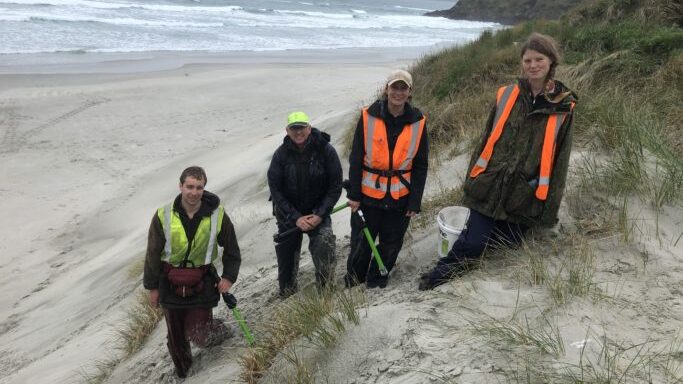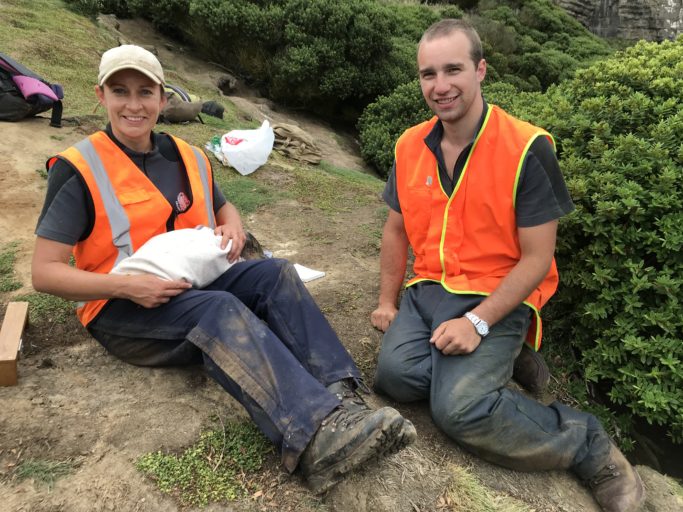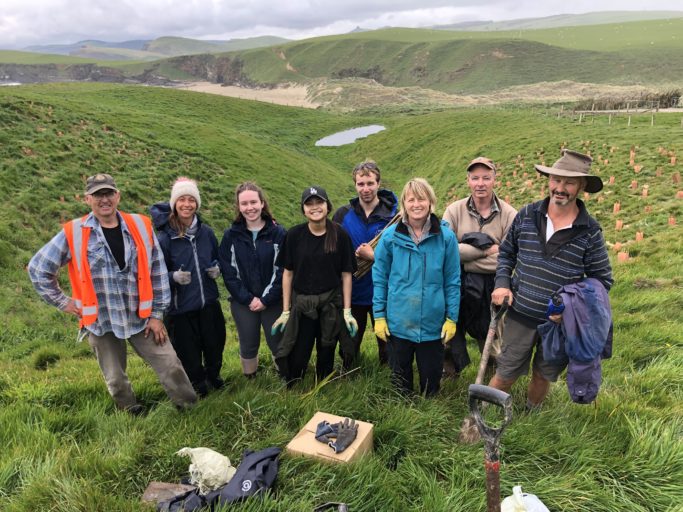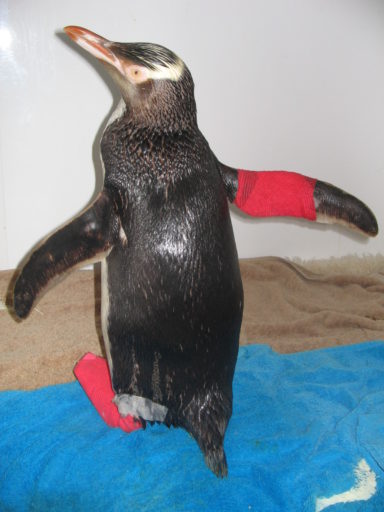It’s ‘all go’ for yellow-eyed penguins – 2019 Bird of the Year – and those who help protect them. ‘Penguin Season’ is underway in Otago and Southland as staff and volunteers from the Yellow-Eyed Penguin Trust search for this year’s nests in North Otago, Otago Peninsula and the Catlins.

Dave McFarlane is Field Manager for the Trust, looking after the operational side of things. “I originally began as a ranger from 2003-2006 and then moved into the Field Manager role and have been here ever since,” Dave says. “It’s the best job I’ve ever had!”
The YEP Trust also covers sites in Rakiura and Whenua Hou, with a mix of Trust reserves, private land and also conservation land, where they support the work of DOC.
“Our Ranger – Ben Goldsworthy, is also taking part in a DOC led trip to Campbell Island in November that will be monitoring hoiho,” Dave says.
Penguin season begins in early October with nest searching and continues right through to the end of adult moult checks in late April /early May.
“Following nest searching the monitoring regime involves regular checks of nests and monitoring the health of adults and chicks,” says Dave. “If necessary, for instance in the event of injury, disease or starvation we will intervene and take birds in for veterinary care or rehabilitation.”
Some birds well-known to the Trust, have had a number of wildlife adventures over the years and multiple reasons to be grateful for human intervention.

“Many penguins have stories to tell, especially with the roll out of transpondering over the last 10 years,” Dave explains. “Most of the mainland population is now marked and we can tell for instance how many times they have been to the Dunedin Wildlife Hospital or Penguin Place for rehabilitation. One penguin named Crystal has been to DWH three times since 2017 for treatment following encounters with marine predators.”
Penguin Place on the Otago Peninsula is also a key part of the penguin-care process and has its rehabilitation facility. Working alongside conservation rangers and the Dunedin Wildlife Hospital it provides the essential third leg of the programme to save the hoiho.
“They either take in penguins directly for feeding (TLC!) or injured birds that have been treated by the Dunedin Wildlife Hospital and need to recuperate,” Dave explains. “Penguin Place is owned by the McGrouther family and provides rehabilitation to hoiho on the Otago Peninsula and from the Catlins. Hundreds of penguins were successfully cared for there, requiring tons of donated fish.”
Yellow-eyed penguins can be quite long-lived, if they survive the hazards of predation or starvation on land or at sea. The oldest penguin monitored by the Trust was around 25 years of age when last sighted some years ago.
“Some breeders are highly successful and the expression ‘super-breeder’ has been coined to describe them,” Dave says. “They consistently fledge chicks and contribute significantly to the population.”
Nevertheless, even with the help of ‘super-breeders’, penguins are struggling to breed successfully.
“Unfortunately, over the last few years the trend has been downwards with 225 breeding pairs on mainland New Zealand (Otago & the Catlins) in 2018-2019, down from 255 the previous season,” Dave says.
The YEPT staff and volunteers are putting in a huge effort to make sure those breeding pairs have the best possible chance. The hours involved in providing this level of monitoring vary greatly over the season and depend to some extent, on how well – or not – the breeding penguins are doing.

“Hundreds of hours of both staff and volunteer time are involved,” Dave says. “For instance, just on its own, a group of Trust volunteers we call the ‘Penguin Transporters’, who are responsible for moving birds to or from the Dunedin Wildlife Hospital or rehabilitation, contributed 144 hours, moved 45 hoiho and travelled 5384km over the 2108-2019 season.”
While mustelids (eg stoats), uncontrolled dogs and tourism impacts, are issues for nesting penguins, they are something the Trust can try to combat with predator control and public education programmes. Increasingly, however, the penguins are facing new challenges at sea.
“We believe that the key threats are found in the marine environment,” Dave explains. “The biggest challenge in 2018-2019 was starvation – the sea wasn’t able to sustain hoiho and at times through the season both chicks and adults starved and needed rehabilitation.”
Monitoring nests regularly means that starving chicks can be identified and helped.
“Nests are visited regularly – probably on average weekly over the season and the data gathered informs management actions,” Dave explains. “For instance, by knowing the hatching date we can work out later in the season, how the chicks are doing and if too light for their age we can take action.”
There is also an extensive programme of predator control and habitat restoration.
“The Trust traps mustelids and cats around hoiho breeding sites and also picks up a substantial by-catch of rats and hedgehogs,” says Dave. “A total of around 300 ha is trapped in some way – using both ‘old school’ fenn traps (inherited from DOC), DOC 200 & 250 traps and Steve Allen cat traps. Trap.nz is used to collect trapping data and manage the trapping effort.”
“We plant around 1,000 trees and shrubs and several thousand flax every season, with a planned increase to almost 3,000 trees and shrubs in the coming season. The main planting effort will be at our Long Point Reserve in the Catlins, where habitat restoration improves hoiho nesting habitat, and contributes to general biodiversity.”
Some staff are employed by the Trust, with a huge volunteer contribution also essential to their work.
“The Trust employs 6-7 FTE (full-time equivalent) staff, made up of a General Manager, Admin Support, Field Manager, Dunedin Ranger, Nursery Supervisor, Scientist, Catlins Ranger and a Rakiura Seasonal Ranger,” says Dave. “In the 2019 year to date, volunteers have also contributed 1141 hours in habitat work for the Trust.”
Habitat work includes tasks such as penguin monitoring, restoration planting, trapping and weed control. Volunteers also work in the Trust’s plant nursery and on the Trust Board.

“A particularly successful initiative has been our appointment of emerging trustees onto the Board, bringing a younger view to board deliberations,” Dave says.
Other volunteers have been there since the beginning.
“I believe are longest serving volunteers are our two founding trustees that still serve on the Trust Board and our newspaper clipping volunteer. All three have been involved since 1987,” Dave says.
The Yellow-Eyed Penguin Trust also has a long and successful relationship with its key sponsor, Mainland.
“Mainland /Fonterra is the Trust’s founding sponsor, having donated to our work for 30 years,” Dave says. “The sponsorship contributes $75,000 annually. It is believed that the Fonterra cause-related marketing sponsorship is the longest for an environmental NGO in the southern hemisphere!”
Dave reckons there are probably too many Trust supporters to mention in detail.
“I’d risk missing some! Suffice to say that there are lots, from central government to local government, corporates and companies of all sizes and private individuals making generous bequests. Underlying it all is a loyal membership,” he adds, “Some of who have been Trust supporters since the founding in 1987.”
The new Dunedin Wildlife Hospital is also proving to be essential in the struggle to help yellow-eyed penguins and other native wildlife.
“For many years a Dunedin vet also donated their time to care for hoiho, but as the demand grew the Trust funded a pop-up wildlife hospital in Dunedin for two years,” Dave explains. “The subsequent formal establishment of the Dunedin Wildlife Hospital has been vital in coping with the influx of hoiho, as intensive reserve monitoring and management is undertaken. To illustrate the importance of the hospital, during the 2018-2019 season it looked after 400 plus yellow-eyed penguins!”
The public can play a role too, by joining, volunteering and/or donating to groups like the YEP Trust, by being watchful and respectful of wildlife they encounter on the beach, especially if walking their dog. People can also help to raise awareness among other beach-users by respectfully speaking up if they encounter someone with an uncontrolled dog or a beachgoer who is disturbing wildlife in pursuit of a cellphone ‘selfie’.

